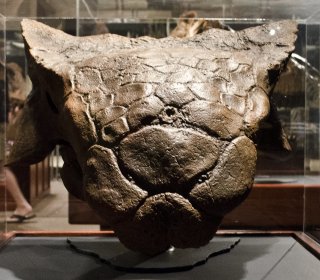Stomach Contents Reveal Armored Dinosaur’s Last Meal 110 Million Years Later
Cue Jurassic Park's theme music.
The last meal of a huge armor-plated dinosaur has been revealed 110 million years later.
The remains of the feast—still in the dinosaur’s fossilized stomach—were recently detailed in the journal Royal Society Open Science.
“This new study changes what we know about the diet of large herbivorous dinosaurs,” the study’s co-author Caleb Brown, a paleontologist at Royal Tyrrell Museum, said in a release.
“Our findings are also remarkable for what they can tell us about the animal’s interaction with its environment, details we don’t usually get just from the dinosaur skeleton.”
Such evidence of dinosaurs’ diets is rarely ever preserved. In some instances, seeds and twigs have been found in remains but never conclusive proof about certain plants that were consumed.
In this particular case, a muddy sea-floor tomb was able to preserve the dinosaur and its stomach contents remarkably well.
“The finding of the actual preserved stomach contents from a dinosaur is extraordinarily rare, and this stomach recovered from the mummified nodosaur by the museum team is by far the best-preserved dinosaur stomach ever found to date,” University of Saskatchewan geologist Jim Basinger, a member of the team that analyzed the dinosaur’s stomach contents, said in a release.
“When people see this stunning fossil and are told that we know what its last meal was because its stomach was so well preserved inside the skeleton, it will almost bring the beast back to life for them, providing a glimpse of how the animal actually carried out its daily activities, where it lived and what its preferred food was.”
This ancient beast was a nodosaur, known as Borealopelta markmitchelli (means “Northern shield”), and was initially discovered in 2011 during mining operations north of Fort McMurray in Alberta, Canada.
Since then, researchers at the Royal Tyrrell Museum of Paleontology have worked tirelessly to unlock the nodosaur’s many secrets.
As for the last meal, it “was mostly fern leaves—88 percent chewed leaf material and 7 percent stems and twigs,” the study’s co-author David Greenwood, a Brandon University biologist and University of Saskatchewan adjunct professor, said in a release.
“When we examined thin sections of the stomach contents under a microscope, we were shocked to see beautifully preserved and concentrated plant material. In marine rocks we almost never see such superb preservation of leaves, including the microscopic, spore-producing sporangia of ferns.”
Ethen Kim Lieser is a Science and Tech Editor who has held posts at Google, The Korea Herald, Lincoln Journal Star, AsianWeek and Arirang TV. He currently resides in Minneapolis.

